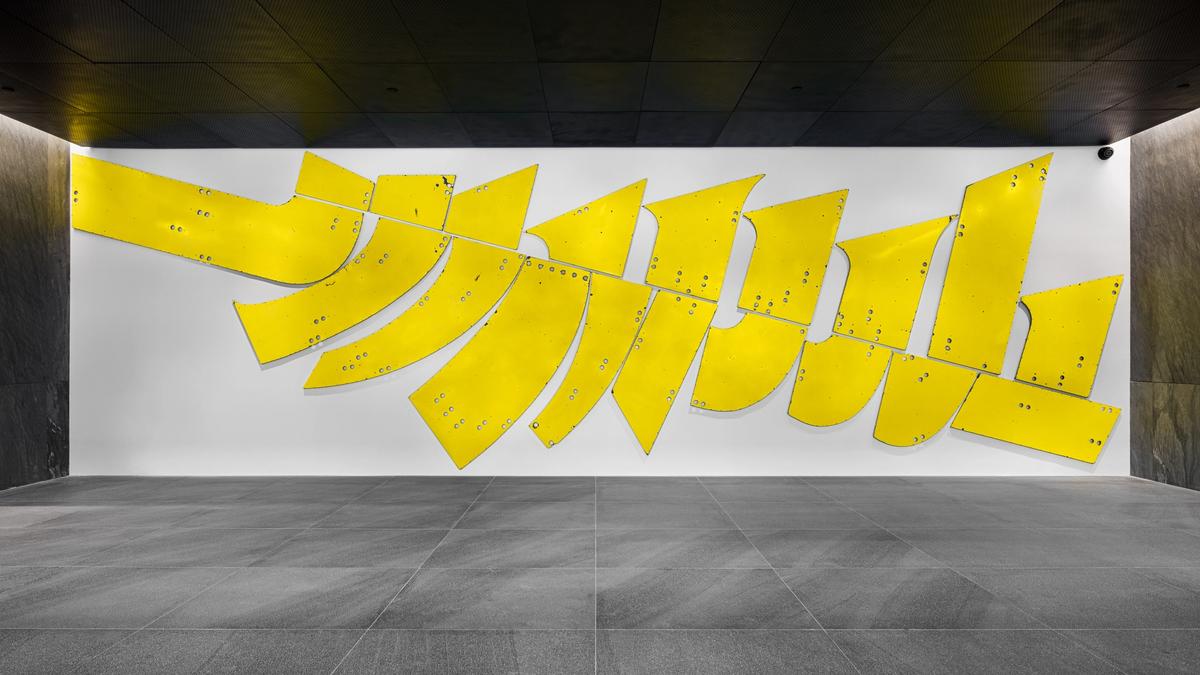In a nondescript building in Brooklyn’s Williamsburg neighbourhood, buckets full of rusty screws, milk crates overflowing with antique transformers and giant piles of scrap metal are lovingly arranged by type, colour, size and shape, and tucked into the back and corners of a ground-floor industrial space—as if someone who worked their whole life at a craft store were suddenly in charge of a scrap yard.
The Brooklyn-based artist Virginia Overton, responsible for this marvel of organisation, has used the space as her studio in the past year for a single project: a brand-new wall sculpture employing parts of the iconic old “Domino” sign that once graced the top of the sugar factory on the waterfront near the Williamsburg Bridge about a mile away. Her piece, Untitled (reverse virgule) (2024), has just been unveiled in the lobby of the newly revamped Domino Sugar Refinery office building, and all of these miscellaneous corroded items are the dregs of the sign—everything left, thus far, unused.
“For sure, the rest will get incorporated into other things,” Overton tells The Art Newspaper reassuringly, noting that taking things apart, examining the pieces and putting them together with parts from other dismantled items is what she does best. “It’s kind of like a mining process, revealing the potential and separating it out. I like a constant new approach.”
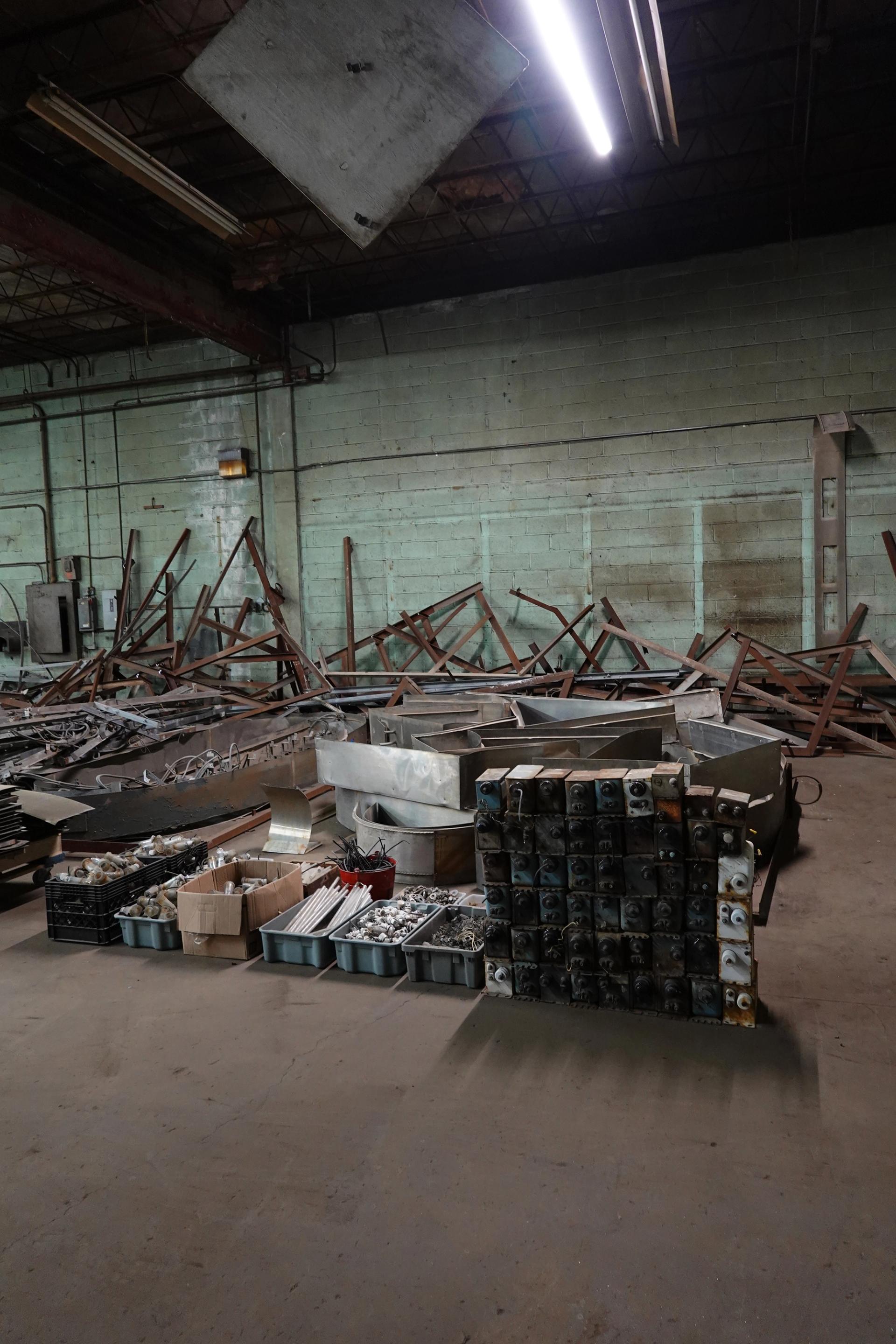
Inside Virginia Overton's painstakingly organised Williamsburg studio Courtesy the artist
It took Overton six months to take apart the letters, piece by piece, that once made up the 45ft-by-65ft neon “Domino” sign. She excitedly shows off some broken bits of the original neon tubes that she had an expert repair so she could experience the true colour of the light against the yellow enamelled-steel letters. She would later use a piece of neon tube, together with some of a letter’s steel armature, to make Untitled (paired) (2024)—on view at White Cube’s stand at Frieze New York this week. “Each component is flimsy, but when you put it together, it’s this formidable object. And some of the transformers still work!” Overton says with glee as she points out a pile of boxes filled with the electrical components in the back of her studio.
The part of the sign she ended up using in her installation is the memorable yellow of the letters. After meticulously cleaning years of grime off of them with liquid Bar Keepers Friend, she rearranged some (not all) of the letter pieces into an abstract 11ft-by-38ft wall sculpture—the final layout is only one of 75 different iterations she tried.
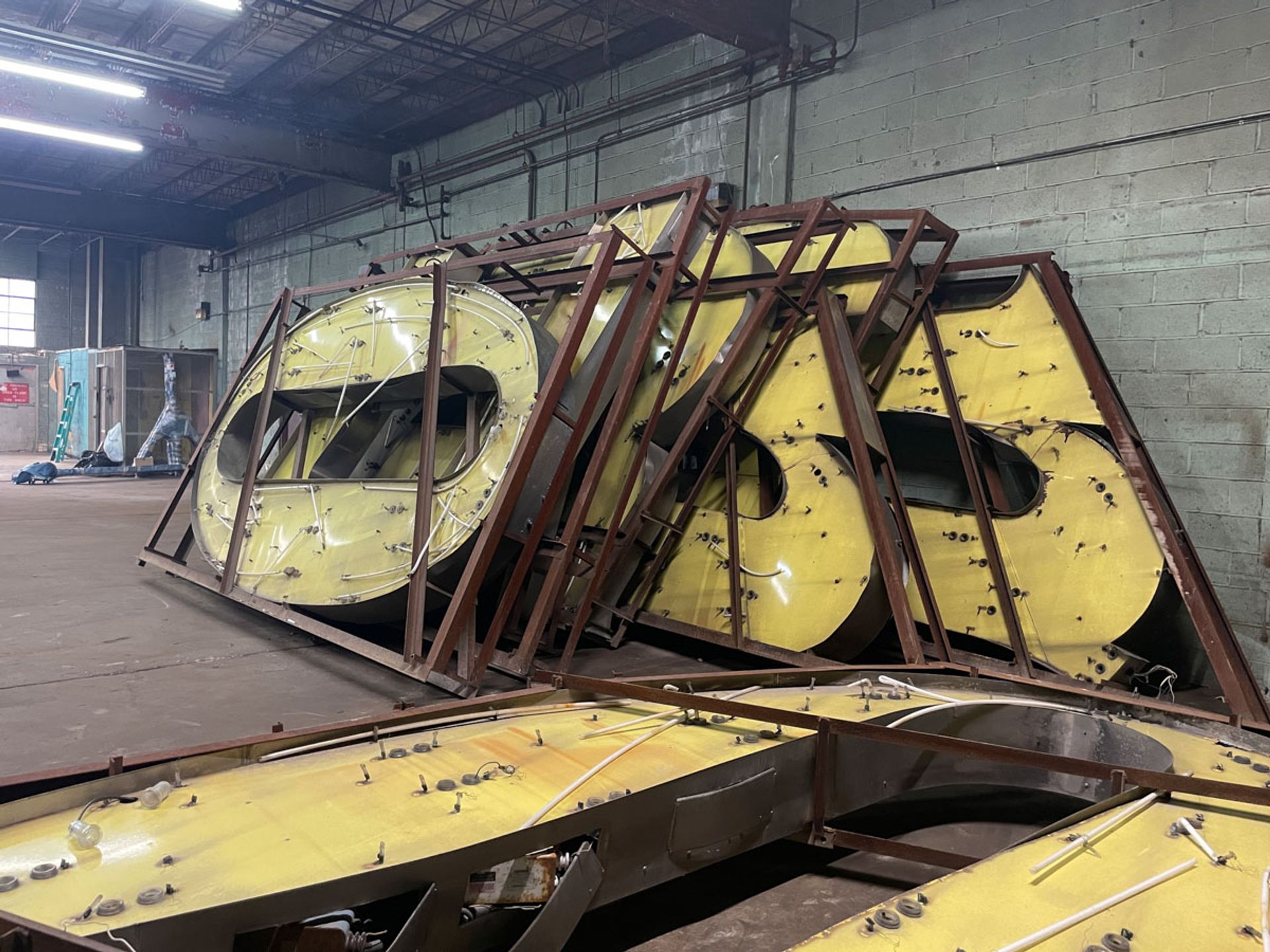
Letters from the "Domino" sign stacked in Virginia Overton's studio before she started dismantling them Courtesy the artist
“I didn’t cut anything. I wanted the material to push back on me a little bit and to honour the way the sign was made and the hands that made it that way,” she says. “It’s all handmade, and I was hoping that when we took it apart, there would be a time capsule inside.” (There was no time capsule, but Overton did find an “unknown animal nest” in one of the letters.)
The hands that made this particular sign (installed in 1967) were employed by Artkraft Strauss, a New York-based signmaker that “did all of Times Square”, says Kate Gavriel, cultural affairs director at Two Trees Management, the real-estate company responsible for the transformation of Domino’s Brooklyn campus and commissioner of Overton’s project. Among the historic Artkraft Strauss signs were a 1940s Camel-cigarettes ad that blew smoke rings out of the billboard and a massive Coke bottle that would be seemingly (and continuously) opened and consumed by an invisible giant in the 1990s. Artkraft Strauss was also responsible for making and dropping the Times Square Ball on New Year’s Eve, starting with the event’s inception in 1907 until 1996. And on the other side of the East River, the company crafted the 1940s “Pepsi-Cola” sign in Long Island City that now greets ferry commuters.
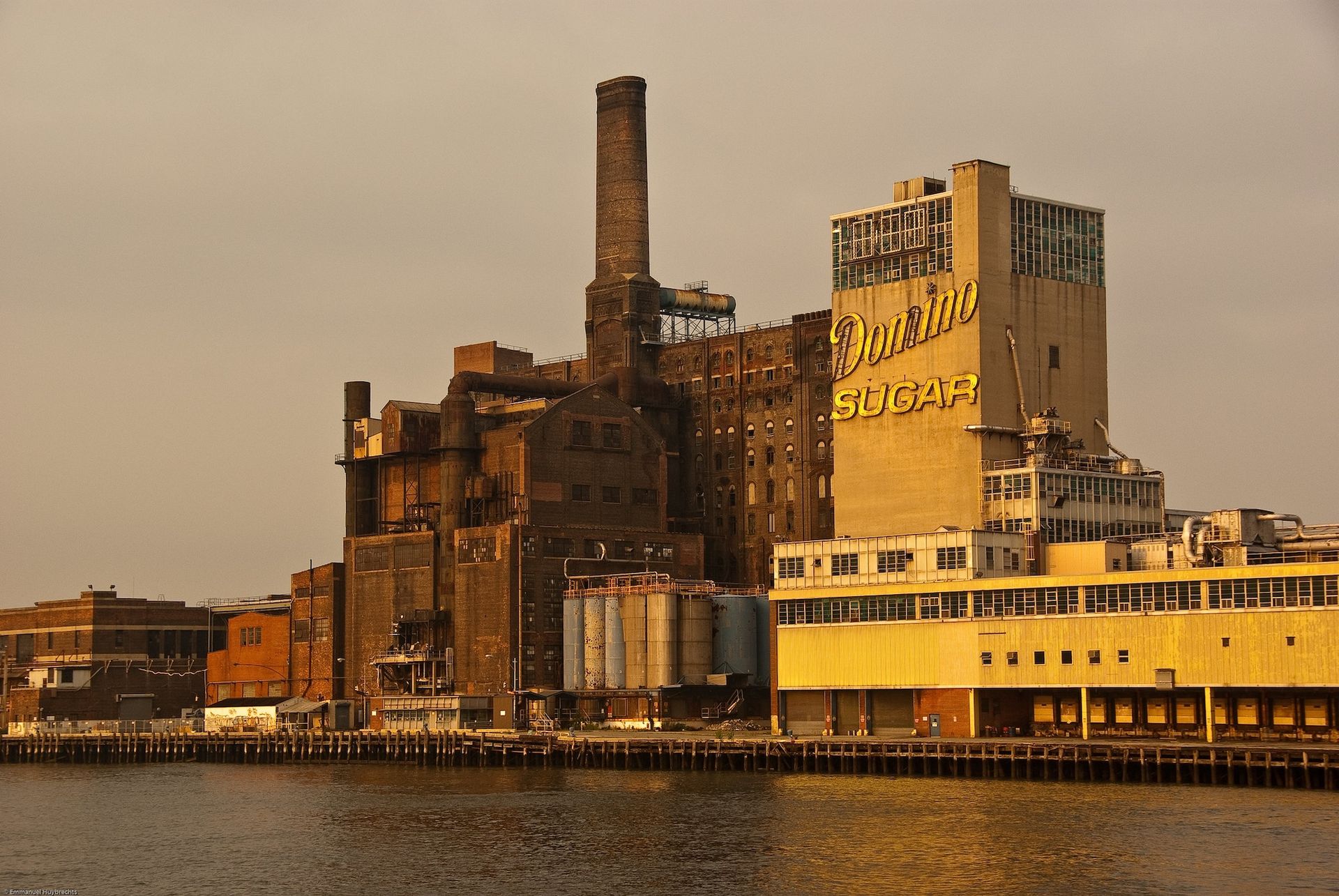
Brooklyn's abandoned Domino Sugar refinery in 2008, with Artkraft Strauss's 1967 sign still in place Photo: Manu H via Flickr
Overton’s sign (the third “Domino” sign to grace the building) was taken down and the letters separated in 2014, ten years after the sugar factory closed. As Gavriel puts it: “The sign hung out on the site, since it was weatherproof and designed to be outdoors.” While an exact replica of the sign was eventually created to top the gut-renovated building, the original was left for years in a lot nearby, too big to fit in a storage container—even in its dismantled state. (“It could live outside, it was so well-built,” Overton says.)
When Two Trees first approached Overton to make a public project for the transformed Domino building four years ago, the artist says she immediately thought of using the sign, but the company Domino Foods needed some convincing. (Although the sugar industry has been falling in favour of high-fructose corn syrup and other sweeteners in the past few decades, the Domino Sugar plant in Baltimore Harbour is still up and running.)

Disassembling the letters in Virginia Overton's studio Courtesy the artist
Gavriel says that Domino Foods’ main concern was: “What will it look like with our brand made into an artwork?” So she made a “packet of Virginia’s work to show Domino, and they were pleasantly surprised. I’ve been a fan of Virginia’s work for a long time. I enjoyed the Socrates show she had. I was taken by her work responding to industry, but she also has a body of work relating to signs.” Gavriel adds that Overton’s work was, importantly, “in line with adaptive reuse and working with salvaged materials”—in the style of Domino Park and the Brooklyn campus’s other projects—which is why Two Trees approached Overton specifically with this commission.
Overton’s significant recent works include installations at the 2022 Venice Biennale and at the new Delta Air Lines terminal inside New York’s LaGuardia Airport; in both cases, she recalls the histories and materials of the host sites with a focus on labour, craft and industrial design. (She is currently working on a project in Rome, for which she is conducting site visits to local rock quarries for materials and inspiration.)
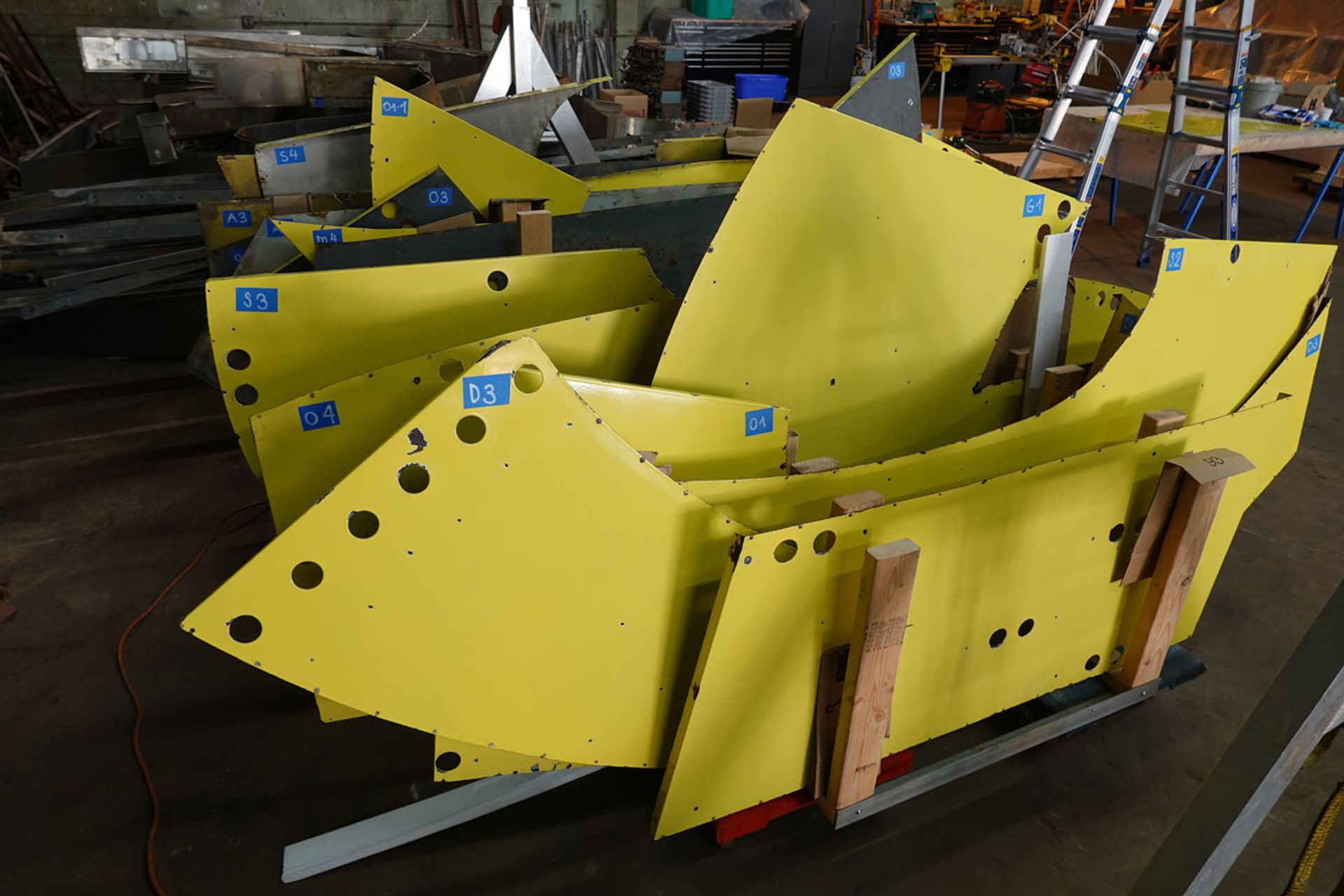
Pieces of the "Domino" letters after Virginia Overton meticulously took them apart and cleaned them with liquid Bar Keepers Friend Courtesy the artist
Overton’s is far from the first public project at Brooklyn’s Domino factory. Perhaps most famously, in 2014—while the site was still in its raw, abandoned state—Kara Walker created a giant Sphinx-like figure made partially of sugar inside the refinery’s cavernous space. A Subtlety, or the Marvelous Sugar Baby (2014), a project organised by the non-profit Creative Time, drew a direct connection between the history of slavery and the sugar industry. The exhibition’s central sculpture was eventually destroyed by the elements, a take on the ruins of empire—like the sugar empire that once existed there.
The American Sugar Refining Company, which owned the Domino Sugar factory, was the largest sugar refiner in the US in the late-19th century, and its Brooklyn base produced most of the sugar used in the whole country. Its founder, the industrialist Henry Osborne Havemeyer, was also an avid collector of Impressionist art—amassing a large number of works that would later be donated to the Metropolitan Museum of Art. But as sugar gave way to other sweeteners, Domino Sugar slowly shrank and its refineries began to close, falling into disrepair. The shuttered Brooklyn refinery became a New York City designated landmark in 2007, and Two Trees bought it for redevelopment in 2012. In 2018, Domino Park opened on the waterfront. The replica “Domino” sign was mounted on the old refinery building in 2022.
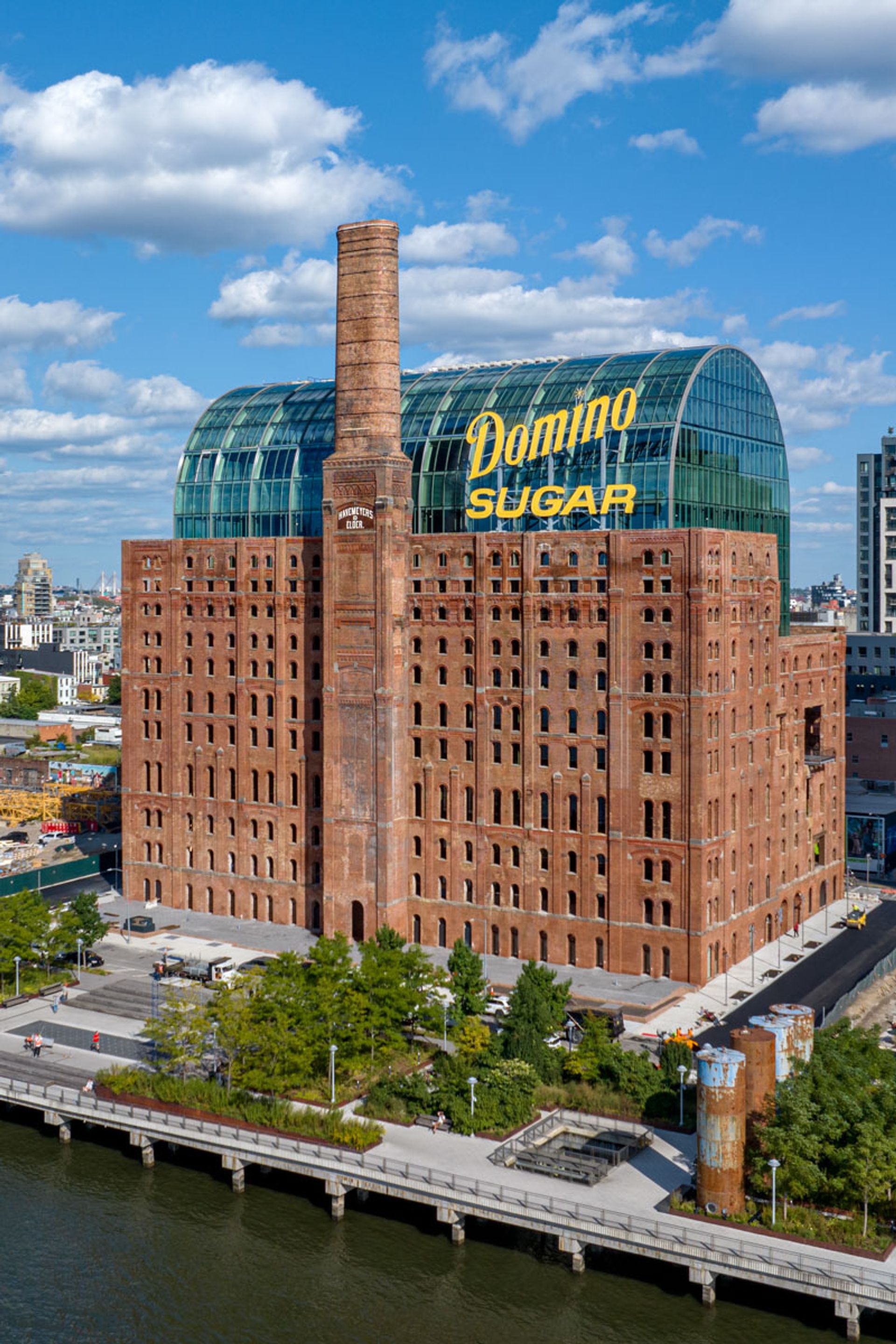
The Refinery at Domino today, with the new replica sign on its roof Photo: Max Touhey, courtesy Two Trees Management
As the architecture critic Justin Davidson noted in his review of the overhauled Refinery at Domino when it opened last year: “At Domino, the present is physically contained within the past and bursts through it at the same time.” Overton’s abstraction of the “Domino” sign is an apt addition to this melding of history and the present day—with a loving eye specifically towards the awe-inspiring craft of the individual (and often anonymous) labourer.


